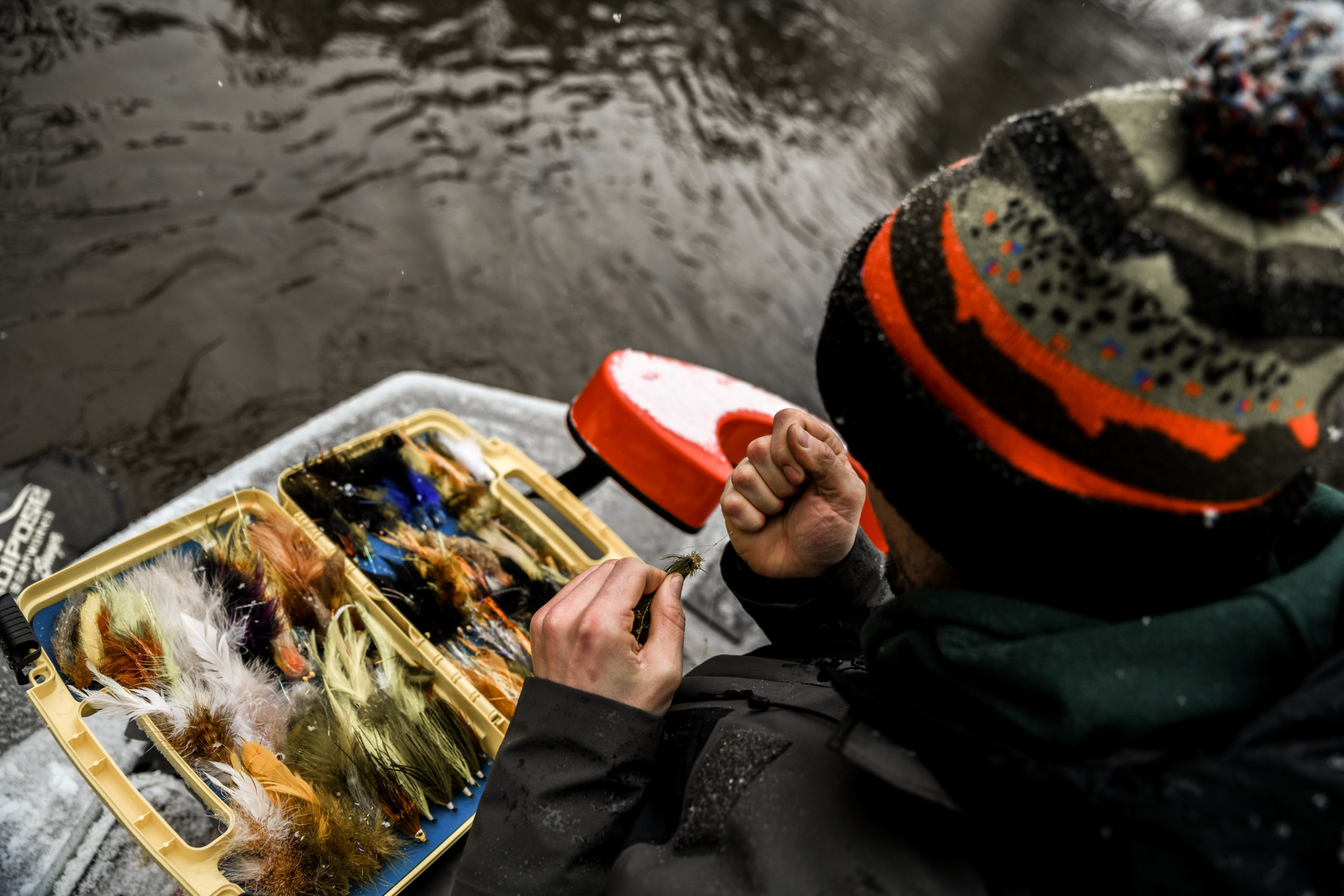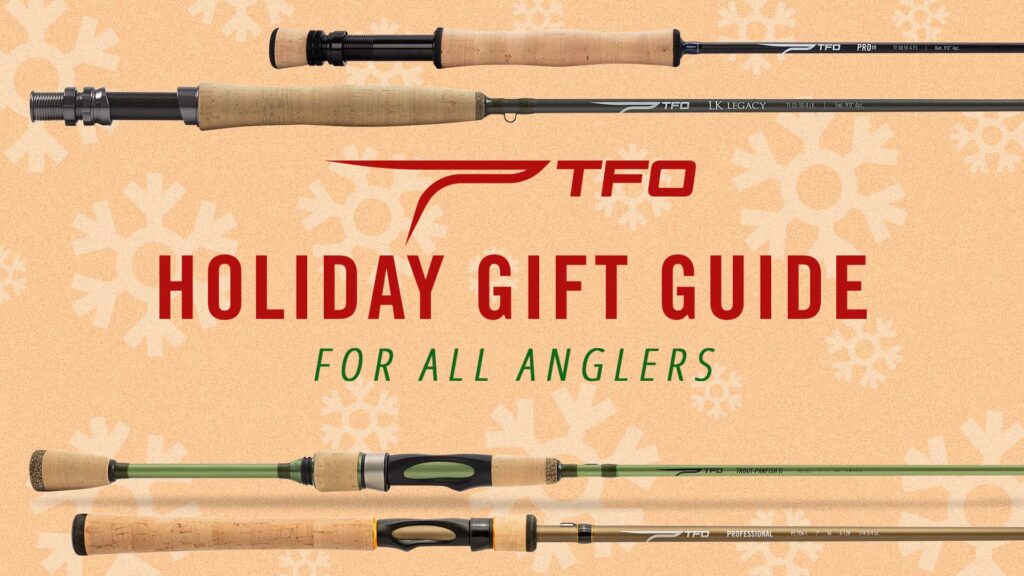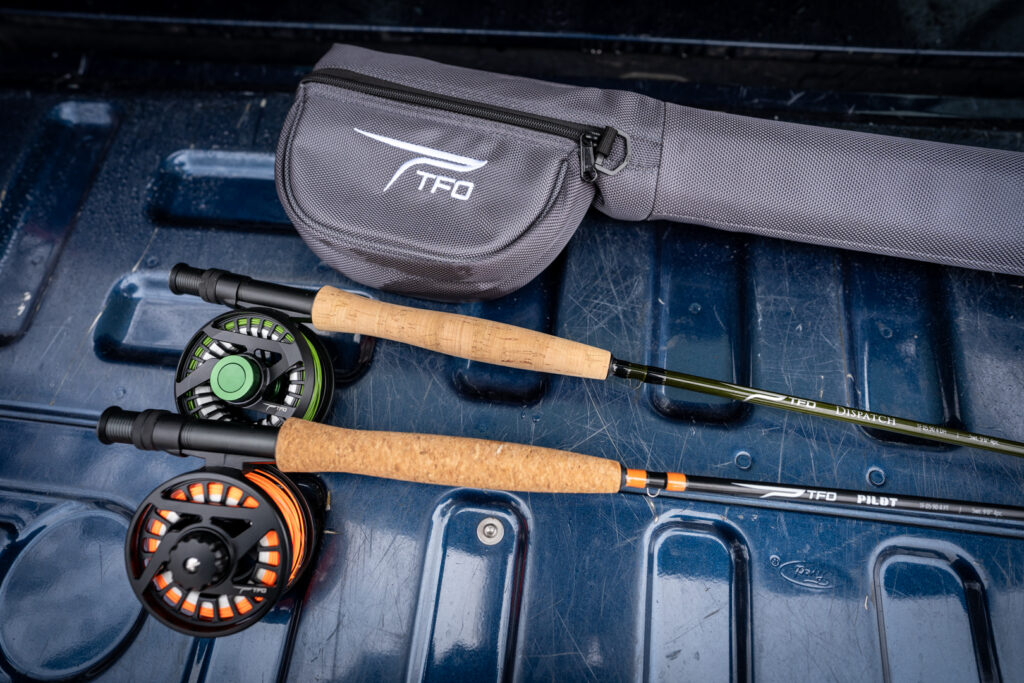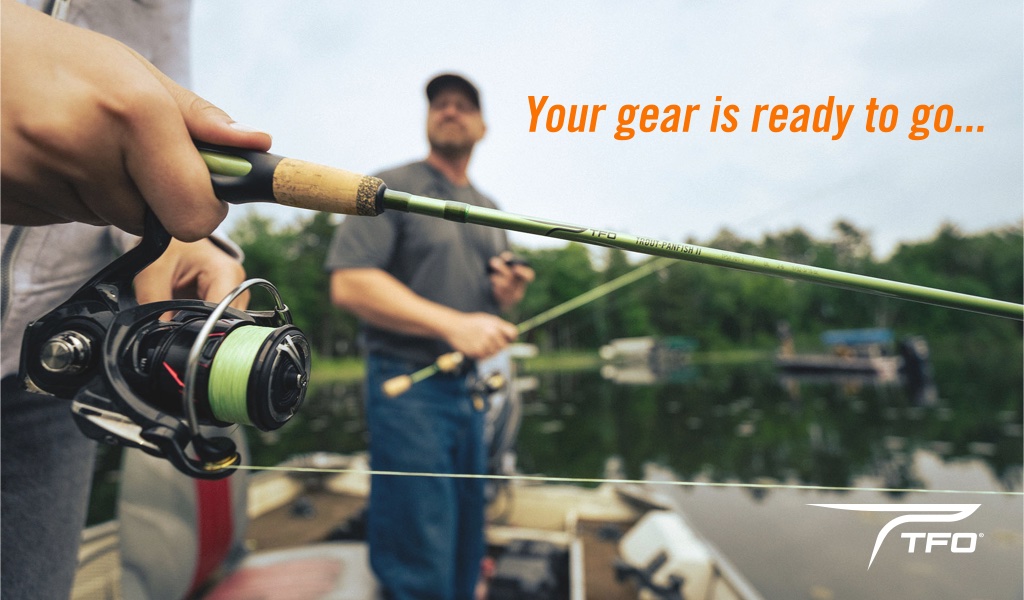“How’s the fishing?” the lady on the bank genuinely inquired.
“We got one in the net, had a few follows- decent day,” my buddy in the bow replied. “But we are just getting to the good water-” I retorted.
“I would go get my drift boat out of the garage, but I only dry fly fish.” she said as she adjusted her position on her deck above the quick flowing seam.
‘What did she just say?’ Sam asked.
‘She only dry fly fishes? That eliminates like 8-9 months of the year on the river.’ I pondered.

Photo: Sam Bosworth
It is an unusually warm early winter day on the river with guide Sam DeJonge of Wild Rise Outfitters. A pleasant air temperature of 47 degrees, we are toasty in fleece and the guides on my TFO Axiom II have not seen ice since last winter. Water temperature is 40 degrees, we are seeing intermittent clouds- we were hoping for a steel wool cloud covered day, but the sun manages to brighten a few runs along the way. We will fish all winter as long as boat launches are accessible. Solid advice to always check the takeout before you put in, they might not get plowed or are a treacherous skating pond from snow melt and re-freeze.
Don’t get me wrong, I get as excited as the next guy/gal when we see that first bug pop in early spring and an eager trout slurps it under the surface- but the streamer game- it gets my heart pumping like nothing else. For most anglers who chase apex predators, it’s all about the MEAT. Why does it seem intimidating? What is the hesitation for an angler to take the next step and buy a seven weight? Or even an eight or nine? I would surmise, in most cases, it is more about hurling a six inch wet tube sock through the air that may cause some trepidation, but that doesn’t need be the scenario. Let’s look at the basics. The hardware- line, rod, reel and flies coupled with the application of river reading and where to place a tasty morsel for hungry trout and how to retrieve your offering are the stuff books are written about. I will break it down for you in three stages. The Gear, The Flies and The Water.

Photo: Sam Bosworth
The Gear
Rod choice – One of the most important tools in the formula. One should choose a rod that can lift and deliver a larger fly to a sometimes tight or difficult location. Best rod weights from six to ten depend really upon the river and species you are chasing and the proficiency of the angler. Smaller streamers like Zonkers or Zoo Cougars can easily be propelled to likely soft seams with a good six weight, I really like the Axiom II or LK Legacy for the responsive roll casts often executed. Choose an eight weight if you need to catapult double deceivers or Gamechangers across the 50-yard line, often better matched with a fast action rod like the Axiom II-X. If you are into a mixed bag of bronzeback and lake fishing, the Blue Ribbon series in seven weight can toss your Lunch $ or a Bad Hair Day all day long. If you are looking in the budget fly rod category, the Pro II comes in under the competition and performs above it’s class. Proper pairing of line weight to the rod’s capabilities are paramount. We shall cover that next.

Photo: Sam Bosworth
Line Choice – We need to get the fly in front of the fish. Even if the fish has already eaten, placing a sculpin or crawfish pattern in front of a 24-inch brown forces the fish to react aggressively. Divide the river column into thirds, top third is 1-2 feet of depth, middle section 3-5 feet, and the bottom is 6-8 feet of depth. We like to use Scientific Angler’s Sonar Titan for many Michigan rivers. The Hover sink 2/4 can cover the top 2/3 of the river effectively with proper fly choice. Sonar Sink Intermediate 3/5/7 can get you in the deeper slots, and if you really want to get down, go Full Sink, but be wary of the all the woody debris- you may lose a Bangtail or two. Many are going to argue some flies can go deep if you use a full sink line, and that often works, but don’t double down with a full sink and a conehead Fishwhacker or you will go broke buying flies. Keep your leader short. Really short. Some anglers try to switch from their 9-11′ leader and can’t figure out why they are missing targets. I will tie a two-foot section of 30# shock tippet with a barrel swivel to 2- 3′ of 12-15# flourocarbon. Keep it under 6 feet long, you will amaze yourself with how well you can roll that heavier wet Grumpy Muppet under some overhanging brush when the heavy taper of your line gets your leader on point.
The Reel – Don’t over think this one, but DO NOT dismiss it either. Get a quality reel, decent arbor size, I prefer large arbor for quicker line pick up and retrieve. I have witnessed more fish lost when an angler is fumbling around with a load of line at his feet and he can’t seem to get enough line on the reel to get the upper hand before his 24″ brown takes his leader to log town and ‘POP!’ I have also witnessed fish charge the boat or go upstream and the slack in the line allows for the fly to ‘fall out’ on a poor hook set. Be sure you have a substantial drag that has quick initial start up, sealed drag is a bonus on the often sandy Michigan rivers. The newly designed BVK SD between $200 and $240 fits all these requirements- even for saltwater.

Photo: Sam Bosworth
The Flies
Fly choice – When you mention ‘streamer’ to certain crowds out West, they immediately think of cute flies like the Autumn Splendor and Woolly Bugger- those flies certainly have a time and place, but most often we are using articulated flies to imitate bait. Sculpin, crawfish, darters/dace, shiners/chubs and smaller trout- these are all on the menu for the fish who have achieved a certain size class. Flash is good, not too much, not too little, often it’s the only thing that allows you to track your fly in the water. The old adage bright fly bright day often applies, but don’t be afraid to go black- it can save the day. We also have plenty of leeches/chestnut lamprey and baby coho/steelhead smolt that add to the dinner features on most rivers that connect to the Great Lakes, perhaps this is why our streamer game is so different. Most often, it is best to try to match the color of the natural surrounding, the bottom. Olive, is a key color on the Manistee, but I have a good buddy who most often throws yellow, and his Instagram account will back his color choice. Kelly Galloup, who, along with Bob Linsenman, pioneered much in our way of thinking for ‘how to fish’ and what to tie for streamer patterns- they actually cowrote the book some 20 years ago ‘Modern Trout Streamers‘. Most flies are either versions of Kelly’s vast arsenal of witty named feathered configurations, but also some of the guides who either worked with Kelly when he was in Michigan or thousands of tyers who have watched countless hours on YouTube and his tying tutorials. Russ Maddin brought us the Circus Peanut and recently updated with the Chromatic Peanut, easily one of my top five flies for rivers we fish. Kelly adapted this pattern with the Peanut Envy. His streamer patterns like the Sex Dungeon, Zoo Cougar, Silky Kitty, Knappy Sculpin, Double Madonna, Barely Legal, Bottoms Up and the Woolly Sculpin have all opened our eyes to a wide variety of tying skills and methods of chasing trophy trout. Mike Schultz has brought us the Swinging D and the Swinging D 2.0, while Rich Strolis –Catching Shadows– and his Ice Pick, Hog Snare and Headbanger Sculpin have put plenty of big fish in angler’s nets. Mike Schmidt with Anglers Choice Flies continually bangs out a couple dozen Cotton Candy Deceivers, Viking Midges, Red Rockets, and Meal Tickets for his far reaching fan base. TFO’s very own Blane Chocklett revolutionized the streamer concept with his multiple articulated GameChanger. Primarily a toothy Esox chaser in his guiding days, Blane was out to mimic something that had more lifelike swimming motion. But his patterns have begun a revolution in all aspects of the streamer world and we continue to see evolution as we hit the tying bench.

Photo: Sam Bosworth
The Water
The River – Let’s talk about the water and how to fish it, effectively. The top third of the water column can be searched with patterns such as classics like a Muddler Minnow or Zonkers, but also the forever classic Zoo Cougar or Butt Monkey. If you add a sinking line, you can take some of these more buoyant flies to the next level. Most flies with a lot of deer hair or classic bucktail streamers like the Black Ghost tend to stay in the 1-3 feet zone. Sometimes I find these flies are very effective in early fall for pre-spawn brook trout and can be easily flung on your favorite five weight with an aggressive taper. This brings us to the middle column, 2-5 feet of depth, often targeted by floating anglers because you can tempt a fish up from the bottom or out of the woody cover without snagging up and losing $8 flies. Intermediate sink or sink tip lines will allow you to get down, especially if you make a downstream roll cast/mend immediately after your fly hits the water. This allows the line to sink with the current and paving a path for your fly to follow in front of that very ominous looking log jam. Great flies for this depth are the Double Boogie Man, Sex Dungeon, Great Lakes Deceiver and Circus Peanut to name a few. Going deep- aka Dredging- we need to be on the bottom, Headbanger Sculpin, Tungsten Conehead Woolly Sculpin, or a conehead Madonna will get down deep and dirty. I have often heard, “better to use the wrong fly at the proper depth, than the right fly at the wrong depth.” Basically, you gotta get the fly in the fish’s face- banging streamers on the bank is a good call, you will get a reactive aggressive strike that simply is the fish exerting dominance over territory, which is why we will see flashes on our streamer and get short strikes or ‘misses’- but sometimes they can’t just stop on a dime when they charge. Never overlook or underestimate the soft inside bend. This is an easy thing to do, especially when the far bank holds a ton of wood and a sweeper that is the very definition of a trout condo, but trust me. That transition water where the sand fades into dark cobble is exactly where a large aggressive fish can disappear into the bottom and wait for a careless brook trout or crawdad to slip out of his comfort zone. These can be camouflaged as shelves or deep gradient slopes, learn to read these tell-tale trout lies and you will amaze yourself in hook up ratio. Get a guide that can show you some of these non-descript looking trout hideouts, the return will be worth your investment.

Be sure to investigate a few spots like the front of a riffle zone or deep behind a down tree that looks like frog water. Big trout, especially in winter months will rest in dark murky water looking for a casual leech or crawfish to pass in front of their noses. There may be many likely looking holds that many trout may inhabit, especially on our wood-laden northern Michigan rivers, but the unlikely looking hold still can hold a trout, only a few less anglers have plied that water. Make a variety of retrieves. Imagine you are the baitfish that just came face to face with with a 22-foot dragon, would you casually walk out of the room, or turn on a dime and high tail it out of there? Make that fly dance and run like it is designed to swim. Sometimes the water temperature will dictate a very slooow thump thump retrieve. Trout will actively feed when water temperature is between 55 and 65 degrees, but post spawn opportunistic trout need to get some weight back on for winter. Spawning season can be stressful on trout, please leave them plenty of room to reproduce and secure future generations of trout to chase the other 11 months of the year.
No matter what you perceive as your preferred fishing method, always leave room to expand your horizons. Whether dry flies are your thing, or maybe you prefer Euro nymphing, having the right gear, the right line, and the “right” water always make for a memorable experience. Get out and enjoy the journey. #fishtheoriginal

Photo: Sam Bosworth
Blog written by Brian “Koz” Kozminski. Koz is the TFO rep for the Great Lakes region and has been affiliated with TFO on various levels for the past six years. He runs a guide service called True North Trout in the off-season (May-October). You can get a hold of Koz on Facebook and Instagram, via email.
![]()







